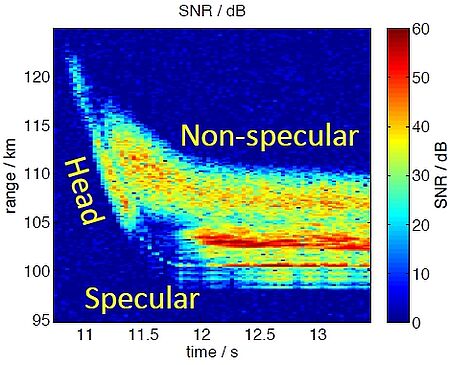- Research Topics
- Department Optical and Rocket Soundings
- Department Radar Remote Sensing
- Department Modelling of Atmospheric Processes
- Working Group Satellite Data Analysis
- Cross-departmental Collaborations
- Projects
- Publications
Meteor observations
There are three different types of meteor echoes that can be observed with radar systems. The most common echoes are the specular meteor trail echoes. These echoes can be detected with small meteor radar systems and offer us the possibility to gain information about the surrounding atmosphere in the MLT region. In the last years several meteor radar networks were developed at IAP to improve the detection rate of these echoes and to enhance the spacial and temporal resolution of waves in the Earth’s atmosphere. In addition, these kind of echoes were observed with MAARSY in a specialised measurement campaign. Within these campaign, it was possible to detect micrometeoroids near the ablation limit (Schult et al., 2020). The observed count rates for slow moving meteoroids in the Earth’s atmosphere was significantly different in comparison to model predictions. Therefore, simulations of meteoroids in the near Earth environment as well as the calculation of the meteoroid masses for the observational method needs further investigation.
The second type of meteor echoes are produced due to radar reflections from small plasma irregularities around the meteoroid particle itself, and are therefore called meteor head echoes. To observe a reasonable number of meteor head echoes, high power larger aperture radar systems are required. We started the first continuous measurements of meteor head echoes with MAARSY in November 2013, which provides us information about the meteor particles and offers us the possibility to gain astrophysical quantities like trajectory parameters, mass estimations and source radians for meteor particle sizes, which are not observable by other techniques. To improve the understanding of the ablation process of meteoroids in the Earth’s atmosphere, the meteor head echo measurements were complemented with two camera systems (Brown et al., 2017). These measurements will be used in further studies to validate ablation models and to quantify ablational parameters, such as the luminous efficiency.
The last and most unknown meteor echoes, at least at high latitudes, are the non specular meteor trails. Such long lasting meteor trail echoes were at first only observed at equatorial and low latitude regions and the scattering process was therefore attributed field-aligned plasma irregularities. The fact that we observe this type of meteor echoes at polar latitudes, has changed our understanding of the underlying scattering process (Chau et al., 2014).

Publications
- C. Schult, G. Stober, D. Janches, J. L. Chau, Results of the first continuous meteor head echo survey at polar latitudes, Icarus, 297, 1-13, 2017. http://dx.doi.org/10.1016/j.icarus.2017.06.019
- C. Schult, P. Brown, P. Pokorný , G. Stober , J. L. Chau, A meteoroid stream survey using meteor head echo observations from the Middle Atmosphere ALOMAR Radar System (MAARSY), Icarus, 309, 177-186, 2018. https://doi.org/10.1016/j.icarus.2018.02.032
- P. Brown, G. Stober, C. Schult, Z. Krzeminski, W. Cooke, J.L. Chau, Simultaneous optical and meteor head echo measurements using the Middle Atmosphere Alomar Radar System (MAARSY): Data collection and preliminary analysis, Planetary and Space Science, 141, 25-34, 2017, 10.1016/ j.pss.2017.04.013.
- J. L. Chau, I. Strelnikova, C. Schult, M. M. Oppenheim, M. C. Kelley, G. Stober und W. Singer, Non-specular meteor trails from non-field-aligned irregularities: Can they be explained by presence of charged meteor dust?, Geophys. Res. Lett., doi:10.1002/2014GL059922, 2014
- C. Schult, G. Stober, P. Brown, P. Pokorn'y und M. Campbell-Brown, Characteristics of very faint (+16) meteors detected with the Middle Atmosphere ALOMAR Radar System (maarsy), Icarus, 340, 1-12, doi:10.1016/j.icarus.2019.113444, 2020.












